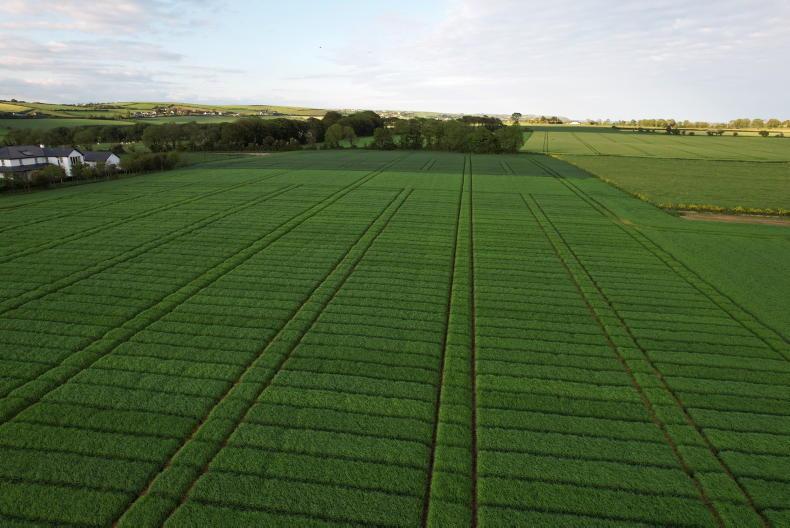Particularly in the EU, where increasingly the policies that define the future of agricultural production are moving towards less reliance on pesticide and fertiliser inputs.
Equally, there is more focus on environmental sustainability in the face of climate change and the challenge for everyone in the agri-food sector is to try and deliver more output but at the same time use less input in the process.
Throw into this mix the geopolitical issues such as the war in Ukraine, COVID-19 pandemic, Brexit, etc, together with the impacts of climate change events and suddenly the fragility of the world’s food supply becomes a major area of concern going forward.

According to Donal Fitzgerald, general manager of arable seeds at Goldcrop, the challenge of producing enough food into the future is not something we can ignore.
Productive
“Irish agriculture is one of the most productive in the world. Recent surveys have shown that Ireland is one of the most climatically secure nations in which to produce food. We don’t suffer from too many extremes of weather and while we might complain about getting too much rain at times, this should be seen as a massive competitive advantage for our farming systems given that many other nations are becoming increasingly deficient in water in most years,” he said.
“Of course, such a climate also presents issues with managing pests and diseases in crops, but modern plant breeding methods are now delivering more resilient and resistant varieties which can overcome such challenges.
"With new technologies, plant breeders are also now able to speed up the breeding process compared to before. The use of gene marker technology facilitates more efficient selection of both genotype in the lab and phenotype in the field”.
Goldcrop have been involved in variety testing in Ireland for almost 40 years and continue to invest in their R&D activities to help find the best cultivars for Irish farming.
Main crops being screened include winter and spring cereals, oilseed rape, beans, maize and beet. The company currently holds the marketing rights for the Teagasc grass and clover breeding programme.
“The variety trials are massively important for us each year. It is the lifeblood of our business to deliver new varieties that are an improvement on what we would have offered previously. Farmers are looking for these new varieties too and, in my experience, we find that Irish growers are excellent at adopting any new technology in the form of varieties, machinery, crop inputs etc. We are also now seeing a greater demand from food and drinks industries for specific quality traits in the produce of some crops and that trend is likely to continue,” says Donal.
While the primary focus on variety trials is usually centred around crop yield, there is an increasing awareness of the importance of finding varieties that are more resilient in the field, regardless of the growing season in play.
Resistance
Disease resistance is of particular importance, especially as the armoury of chemistry available to growers has been reduced, and equally future policy will demand that fewer pesticides are used anyway.
For example, Septoria tritici resistance in winter wheat is now hugely important, together with resistance to other diseases like yellow rust and mildew.
Goldcrop have in recent years enhanced their trialling process to focus on such diseases in wheat and are now involved with numerous breeders to grow hundreds of mini-plots each year to try and identify those lines that are most resistant in our climate.
“We are looking for plots that can stay clean of disease for longer and such lines will then be used by our breeders to make crosses to produce future varieties,” says Donal.
“It is amazing to see how many of the varieties in these plots are just not suited to our conditions and many of our breeders are equally astounded at the level of disease we can get here. It shows the importance of local testing and I think it is fantastic that our Department of Agriculture are also committed to vigorously testing varieties at many regional sites across the country each year which eventually will go towards producing a Recommended List for farmers and industry to use”.

The 2022 winter barley harvest is almost complete, and results have been variable, with yields ranging anywhere from 2.5t/ac to 5.0t/ac. The effects of Take-all and BYDV seem to have been the biggest factors in the yield variances observed, certainly the value of break-crops and a good crop rotation with plenty of ‘fresh ground’ will be huge this year. The harvesting of Winter OSR also began last week, and early indications are that crops are yielding well with excellent reports from some farms.
For Goldcrop, being associated with the Farmers Journal in a Harvest Photo Competition makes logical sense, says Donal.
“Every crop that’s grown starts with a seed and the realisation of the genetic potential within that seed ends with the harvesting of that crop, which in turn is what delivers an earning and a livelihood for thousands of farmers every year. Harvest day is the day that every grower looks forward to each year, when hopefully they can accumulate what they have speculated on since the day the crop was planted, hence we want people to use the tagline #reapwhatyousow when submitting an entry.
So, get those camera’s clicking and best of luck to everyone with their entries!
Enter the competition here






 This is a subscriber-only article
This is a subscriber-only article








